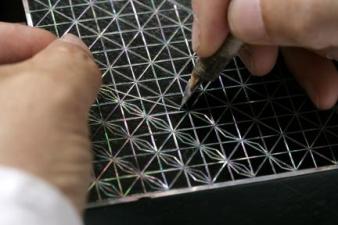EE00002116
 Najeonjang (Mother-of-pearl Inlaying)
Najeonjang (Mother-of-pearl Inlaying)
[National Intangible Cultural Heritage, Republic of Korea]
Najeonjang, or mother-of-pearl inlaying, is a Korean traditional method of decorating the surface of diverse household objects by lacquering and inlaying them with strips of mother-of-pearl. This traditional handicraft is known to have originated from Tang China, but discoveries made at many archaeological sites related with ancient Korean kingdoms prove that Korea has a long tradition of the craft and that ancient Korean people exploited it profusely to produce all kinds of everyday household objects.
To produce a lacquer work inlaid with a mother-of-pearl design, the artisan needs to make a “white frame” with wood first of all. He then lacquers its surface and decorates it by inlaying carefully prepared strips of mother-of-pearl, some of which are as thin as threads, on a prearranged pattern by using the techniques of kkeuneumjil and jureumjil. Each of the individual work processes is completed with a stage of grinding, lacquering, and polishing the surface. In the Goryeo and early Joseon Periods, the most favored designs included peony blossoms, chrysanthemums, and lotus flowers.
Designs became more diverse during the mid-Joseon Period as artisans began to extend their interest to flowers with birds, white cranes, grapes, apricot flowers, and the Four Gracious Plants. The traditional technique of inlaying mother-of-pearl is a time-consuming process that is currently preserved by, among others, two government-designated artisans, Song Bang-ung and Yi Hyeong-man.
Republic of Korea


